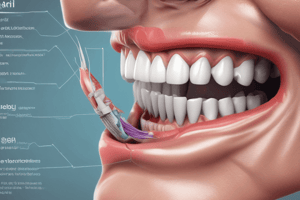Podcast
Questions and Answers
What is the primary difference in size between the maxillary first and second molars?
What is the primary difference in size between the maxillary first and second molars?
1st molar is broader
Which cusp of the maxillary second molar is the largest?
Which cusp of the maxillary second molar is the largest?
- DL
- DB
- MP (correct)
- MB
The buccal groove of the maxillary second molar is located more distally than the 1st molar.
The buccal groove of the maxillary second molar is located more distally than the 1st molar.
True (A)
The roots of the maxillary second molar are _______ diverged.
The roots of the maxillary second molar are _______ diverged.
What shape is often seen in the occlusal outline of the maxillary third molar?
What shape is often seen in the occlusal outline of the maxillary third molar?
Flashcards are hidden until you start studying
Study Notes
Maxillary Second Molar
- 7th from the midline
- 5th cusp is less evident
- Roots are less divergent and less separated
- Both distal cusps are less developed
- The crown is smaller in overall dimensions compared to 1st molar
- Crown is shorter and narrower mesiodistally (MD) than 1st molar
- MB is widest than DB (MD > OC)
- DB cusp is smallest (apart from distal aspect seen)
- Buccal groove is more distally located than 1st molar
- MB root tip is in line with buccal groove
Roots
- Three roots are seen from the buccal aspect
- Root trunk is larger than the 1st molar
- Roots are less diverged, nearly parallel to each other, and distally curved
- A deep developmental groove is present
Palatal Aspect
- Lingual convergence
- MP cusp is largest
- DB cusp is small, smooth, and spheroid
- DB cusp can be seen
- The lingual developmental groove is more distally located
- No Carabelli cusp
Palatal Aspect (continued)
- The roots are seen
- The apex of palatal root is in line with the lingual developmental groove
- Developmental depression on the root surface
- The DL cusp is smaller, and part of DB cusp is seen distal of DL cusp
Mesial Aspect
- Similar to the 1st molar
- Roots are less diverged
- Not widely apart
- Less crown length
- The P and MB roots are within the confines of the BL outline of the crown
Distal Aspect
- The distobuccal cusp is smaller
- More of the MB cusp is seen
- The apex of the palatal root is in line with the distopalatal cusp
- ML cusp of 2nd molar is not seen
Mesial and Distal Aspect
- Like 1st molar except shorter Occlusi-Cervical dimension
- Buccal crest of curvature at cervical third
- Lingual crest of curvature at middle third
- Mesial crest of curvature at junction of occlusal-middle
- Distal crest of curvature slightly more cervical
Occlusal Aspect
- Geometrical outline: more rhomboidal
- BP dimension is greater than the MD dimension
- The crown tapers distally and lingually
- Elevations: 4 cusps and 4 fossae
- Fossa: Oblique ridge
- Marginal ridge: strong and well developed
- Distal marginal ridge is shorter and at a lower level
How to Tell First from Second Molar
- Narrower M-D with second molar
- Both the crown and root are slightly smaller
- The 1st molar is broader than the 2nd molar
- The occlusal surface has more supplementary grooves
- There is no transverse groove of the oblique ridge
- The MB and DB roots are less curved distally in the apical on the 2nd molar and bent towards distally
- The buccal groove is extended and at the end of the groove is the buccal pit in the 1st molar
- Occlusal view of the first is less rhomboidal than the second
- Cusp of Carabelli only on the first
- The roots are not as divergent; they are closer together
- MB root apex is in line with MB cusp tip within the first molar, while in line with the buccal groove in the second molar
Maxillary Third Molar
General Characteristics
- Triangular occlusal outline
- DL cusp is often absent
- Still wider BL than MD
- Roots are shorter, convergent, often fused, and 3 in number
- The ML cusp is the largest
- The crown is shorter cervical line to marginal
- The lingual cusp is well developed and larger than the 2nd
Buccal Aspect
- The MB cusp is wider and longer than the DB cusp
- The roots are often fused, making one large short root
Lingual Aspect
- Usually one large lingual cusp without lingual groove
Mesial Aspect
- Fusion of the roots and the bifurcation in the apical 1/3
Distal Aspect
- Convex surface and the distal surface is short and narrow
- Most of the occlusal surface is seen
Occlusal Variations of 3rd Molar
- Heart-shaped type with three cusps (most common)
- Rhomboidal shape with four cusps
- One cusp type: peg shape
- Congenitally missing
How to Distinguish a Third Molar
- Roots are much shorter than the 1st and 2nd molar
- Roots are shorter than any other tooth (other than mandibular 3rds)
- Roots usually fused
- More supplemental occlusal grooves
- Heart-shape occlusal outline, narrower occlusal table
- MB root larger than DB root
- MB prominence of facial surface
- DLG, if present
- Contact area wear facet only on the mesial
Studying That Suits You
Use AI to generate personalized quizzes and flashcards to suit your learning preferences.




